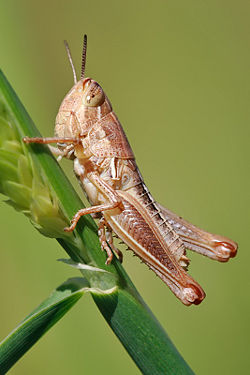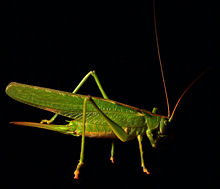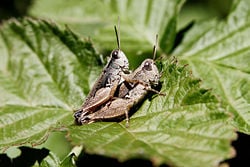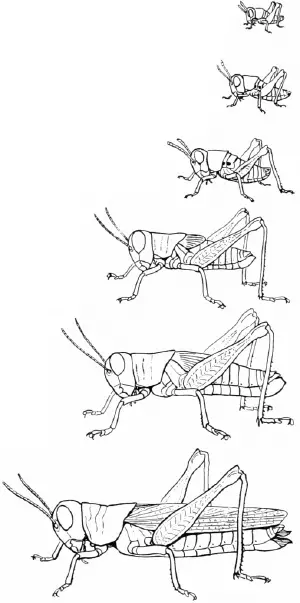Grasshopper
| Caelifera | ||||||||
|---|---|---|---|---|---|---|---|---|
 Dissosteira carolina
| ||||||||
| Scientific classification | ||||||||
| ||||||||
|
Suborder Caelifera (short-horned grasshoppers)
Suborder Ensiferaâcrickets, katydids, and allies
|
Grasshoppers are long and slender insects belonging to the order Orthoptera, typically exhibiting long, strong hind limbs for leaping and powerful mouth-parts for chewing. The term grasshopper is an imprecisely defined name referring most commonly to members of two Orthopteran families: The family Acrididae ("short-horned grasshoppers") of the suborder Caelifera and the family Tettigoniidae ("long-horned grasshoppers") of the suborder Ensifera. Alternatively, "grasshopper" sometimes refers only to the Acrididae, which are then called "true grasshoppers," or in other instances the name is applied exclusively to the entire suborder Caelifera (Capinera et al. 2006). Members of the suborder Caelifera, including therein the family Acrididae, are as a group sometimes called short-horned grasshoppers, in which case members of the suborder Ensifera are called long-horned grasshoppers (Grzimek et al. 2004).
For the purposes of this article, "grasshopper" refers to all members of the suborder Caelifera and also to members of the family Tettigoniidae in the suborder Ensifera.
Caelifera and Ensifera are the only two suborders in Orthoptera. Members of the family Tettigoniidae are commonly known as bush crickets or katydids, and are closely related to the crickets, which are also members of Ensifera, but are not included with the grasshoppers. Caelifera includes the locusts, which are the migratory members of the family Acrididae. Members of both Caelifera and Ensifera are primarily herbivorous species, but Ensifera includes a few carnivorous species.
The Tettigoniidae (long-horned grasshoppers) are typified by antennae longer than the body, while the Acrididae (short-horned grasshoppers) have antennae shorter than the body.
Grasshoppers are integral to natural food chains. Their destructive role as agricultural pests has been reduced in recent years through a better understanding of their population dynamics and development of chemical and biological control measures (Grzimek et al. 2004). The grasshoppers' characteristic sound production, which can serve both to attract mates and to warn of predators, aids the grasshoppers' survival and reproduction while it also adds to the diversity and richness of the human experience of nature.
Caelifera
Types
The suborder Caelifera is classified into 8 superfamilies, 22 families, about 2,400 genera, and over 10,400 described species (Grzimek et al. 2004). Five of these are major families:
- Acrididae (field grasshoppers and locusts)
- Eumastacidae (monkey grasshoppers)
- Tanaoceridae (tanaocerids)
- Tetrigidae(grouse locusts, pygmy grasshoppers, and pygmy locusts)
- Tridactylidae (pygmy mole crickets)
The largest superfamily is Acridoidea with over 7,200 described species in 1,600 genera. The largest family is Acrididae. The family is characterized by the short, thickened antennae and relatively unmodified anatomy. They are often visually more striking than other Caelifera, due to the adults' wings and legs, which are well developed and may be brightly colored. Auditory organs are on the abdomen, unlike on the forelegs of the family Tettigoniidae. The true grasshoppers produce sounds by rubbing their legs against the abdomen, and there may also be a visual display. The Acrididae includes the locusts, which can be serious economic pests.
Life cycle
Grasshoppers develop by incomplete metamorphosis, a process in which the larvae resembles the adults somewhat, as they have compound eyes, developed legs and wing stubs visible on the outside, but the juvenile forms are smaller and, assuming the adult has wings, lack wings. In this mode of development, which involves gradual change, there are three distinct stages: The egg, nymph, and the adult stage, or imago. There is no pupal stage characteristic of complete metamorphosis.
Most orthopterans lay their eggs in the ground or on vegetation. The eggs hatch and the young nymphs resemble adults but lack wings and at this stage are often called hoppers. Through successive molts, the nymphs develop wing buds, until their final molt into a mature adult with fully developed wings.
The number of molts varies between species; growth is also very variable and may take a few weeks to some months depending on food availability and weather conditions.
Eggs are commonly laid in the ground with a foamy substance around them to protect them during incubation; typically the number of eggs laid by a female is between 400 and 500.
Behavior
Diurnal activity is prevalent in the short-horned grasshoppers, when they feed and mate, with nighttime activities including molting and egg laying (Grizmek et al. 2004). This is in contrast to katydids and crickets, which tend to be nocturnal (Grzimek et al. 2004).
Sound production is one of the main characteristics associated with grasshoppers; it is used to attract mates, defend territory, and warn about predators (Grizmek et al. 2004). The calls are generally species specific and the information can be be code in terms of the frequency modulation (pitch changes) or time modulation (pitch changes, but temporal pattern changes) (Grizmek et al. 2004).
Biology
Digestion and excretion
The digestive system of insects includes a foregut (stomodaeum, the mouth region), a hindgut (proctodaeum, the anal region), and a midgut (mesenteron). The mouth leads to the muscular pharynx, and through the esophagus to the crop. This discharges into the midgut, which leads to the malpighian tubules. These are the chief excretion organs. The hindgut includes intestine parts (including the ileum and rectum), and exits through the anus. Most food is handled in the midgut, but some food residue as well as waste products from the malpighian tubules are managed in the hindgut. These waste products consist mainly of uric acid, urea, and a bit of amino acids, and are normally converted into dry pellets before being disposed of.
The salivary glands and midgut secrete digestive enzymes. The midgut secretes protease, lipase, amylase, and invertase, among other enzymes. The particular ones secreted vary with diet.
Caelifera are herbivores, but under conditions such as overcrowding or dehydration, they can attack each other (Grzimek et al. 2004).
Nervous system
The grasshopper's nervous system is controlled by ganglia, loose groups of nerve cells that are found in most species more advanced than cnidarians. In grasshoppers, there are ganglia in each segment as well as a larger set in the head, which are considered the brain. There is also a neuropile in the center, through which all ganglia channel signals. The sense organs (sensory neurons) are found near the exterior of the body and consist of tiny hairs (sensilla), which consist of one sense cell and one nerve fiber, which are each calibrated to respond to a certain stimulus.
While the sensilla are found all over the body, they are most dense on the antennae, palps (part of the mouth), and cerci (near the posterior). Grasshoppers also have tympanal organs for sound reception. Both these and the sensilla are linked to the brain via the neuropile.
Reproduction
The grasshopper's reproductive system consists of the gonads, the ducts which carry sexual products to the exterior, and accessory glands. In males, the testes consist of a number of follicles, which hold the spermatocytes as they mature and form packets of elongated spermatozoa. After they are liberated in bundles, these spermatozoa accumulate in the vesicula seminalis (vas deferens).
In females, each ovary consists of ovarioles. These converge upon the two oviducts, which unite to create a common oviduct which carries ripe eggs. Each of the ovarioles consists of a germarium (a mass of cells that form oocytes, nurse cells, and follicular cells) and a series of follicles. The nurse cells nourish the oocytes during early growth stages, and the follicular cells provide materials for the yolk and make the eggshell (chorion).
During reproduction, the male grasshopper introduces sperm into the vagina through its aedeagus (reproductive organ), and inserts its spermatophore, a package containing the sperm, into the female's ovipositor. The spermatophore, or sperm sack, can also include a large packet of nutritious proteins known as a spermatophylax (Grizmek et al. 2004). The sperm enters the eggs through fine canals called micropyles.
The female then lays the fertilized egg pod, using her ovipositor and abdomen to insert the eggs about one to two inches underground, although they can also be laid in plant roots or even manure. The egg pod contains several dozens of tightly-packed eggs that look like thin rice grains. The eggs stay there through the winter, and hatch when the weather has warmed sufficiently. In temperate zones, many grasshoppers spend most of their life as eggs through the "cooler" months (up to nine months) and the active states (young and adult grasshoppers) live only up to three months. The first nymph to hatch tunnels up through the ground, and the rest follow. Grasshoppers develop through stages, progressively getting larger in body and wing size (incomplete metamorphosis). Grasshoppers can lay eggs underwater.
The orthopteran courtship and mating behaviors are among some of the "most complex and fascinating spectacles in the insect world," involving sound production and visual, tactile, and olfactory signals (Grzimek et al. 2004).
Circulation and respiration
Grasshoppers have open circulatory systems, with most of the body fluid (hemolymph) filling body cavities and appendages. The one closed organ, the dorsal vessel, extends from the head through the thorax to the hind end. It is a continuous tube with two regionsâthe heart, which is restricted to the abdomen, and the aorta, which extends from the heart to the head through the thorax. Hemolymph is pumped forward from the hind end and the sides of the body through a series of valved chambers, each of which contains a pair of lateral openings (ostia). The hemolymph continues to the aorta and is discharged through the front of the head. Accessory pumps carry hemolymph through the wing veins and along the legs and antennae before it flows back to the abdomen. This hemolymph circulates nutrients through the body and carries metabolic wastes to the malphighian tubes to be excreted. Because it does not carry oxygen, grasshopper "blood" is green.
Respiration is performed using tracheae, air-filled tubes that open at the surfaces of the thorax and abdomen through pairs of spiracles. The spiracle valves only open to allow oxygen and carbon dioxide exchange. The tracheoles, found at the end of the tracheal tubes, are insinuated between cells and carry oxygen throughout the body.
Locusts
Locusts are grasshoppers that are characterized by behavior. They are defined as several species of short-horned grasshoppers of the family Acrididae that have solitary and gregarious (swarm) phases. They do not belong to a particular genus or subfamily, but are those species of grasshoppers that exhibit behavioral, morphological, and physiological changes from a solitary phase to a migratory phase (Grzimek et al. 2004). For example, the desert locust (Schistocerca gregaria) of Africa and Asia are normally solitary, but the spring rains trigger a behavior transformation that can result in single swarms larger than any other single congregation of organisms on Earth, ranging from 100,000 to 10 billion insects (Grzimek et al. 2004). One swarm in 1794 once spread over 5,000 square kilometers (almost 2,000 square miles) (Grzimek et al. 2004).
Gallery
Grasshopper, United Kingdom
Tettigoniidae
| Tettigoniidae | ||||||||||||||
|---|---|---|---|---|---|---|---|---|---|---|---|---|---|---|
 Great green bush-cricket
(Tettigonia viridissima) | ||||||||||||||
| Scientific classification | ||||||||||||||
|
The family Tettigoniidae contains the more than 6,800 species known in American English as katydids and in British English as bush-crickets. It is one of 21 families in the suborder Ensifera and the only family in the superfamily Tettigonoidea, the largest superfamily of this suborder. Although also known as "long-horned grasshoppers," they are more closely related to crickets than to the true grasshoppers.
Tettigoniids may be distinguished from true grasshoppers by the length of their antennae, which may exceed their own body length, while in Acrididae are always relatively short.
The name "katydid" comes from the sound produced by species of the North American genus Pterophylla] (literally "winged leaf"). The males of katydids have sound-producing organs (via stridulation) located on the hind angles of their front wings, which in some species produce a sound thought to resemble the English words "Katy did, Katy didn't," hence the name. In some species, females are also capable of stridulation.
There are over 250 described species in North America, but the majority of species live in the tropical regions of the world.
The diet of tettigoniids includes leaves, flowers, bark, and seeds, but many species are exclusively predatory, feeding on other insects, snails, or even the young of small vertebrates such as snakes and lizards. Some are also considered pests by commercial crop growers and are sprayed to limit growth.
The spikeheaded katydid is somewhat notorious for its plantlike appearance, which allows it to blend in with the vegetation on which it lives, and the spikes discourage potential predators.
Grasshoppers and humans
In many places around the world, grasshoppers are eaten as a good source of protein. Orthoptera also are the only insects considered kosher in Judaism. As stated in the Book of Leviticus in the Bible:
All winged swarming things that walk on fours shall be an abomination for you. But these you may eat among all the winged swarming things that walk on fours ⌠locusts of every variety; all varieties of bald locust; crickets of every variety; and all varieties of grasshopper.
However, different opinions exist on which exact species are considered kosher. The Jewish Torah states that the flying insects with four walking legs that are kosher are those whose knees extend above their feet to hop on the ground (Grzimek et al. 2004).
Raw grasshoppers should be eaten with caution, as they can contain tapeworms.
Grasshoppers have traditionally been agricultural pests. Grasshopper outbreaks caused significant problems in the United States in the eighteenth, nineteenth, and twentieth centuries, including major outbreaks in New England in the mid-1700s, and in the Great Basin and Great Plains in the mid 1800sâwith great plagues in 1874-1876 in the Great Plains (Schlebecker 1953). The 1936 grasshopper plague destroyed great numbers of crops in the Midwest and South (Schlebecker 1953).
Locusts outbreaks have been particularly noteworthy. Locusts can form very large swarms that can migrate in a more or less coordinated way and cause massive damage to crops. Important locust species include Schistocerca gregaria and Locusta migratoria in Africa and the Middle East, and Schistocerca piceifrons in tropical Mexico and Central America. Other grasshoppers important as pests (which, unlike "true" locusts, do not change color when they form swarms) include Melanoplus species (like M. bivittatus, M. femurrubrum, and M. differentialis) and Camnula pellucida in North America; the lubber grasshopper Brachystola magna and Sphenarium purpurascens in Northern and Central Mexico; and species of Rhammatocerus in South America.
Swarming is not limited to the suborder Caelifera, as some katydids can form large swarms (Grzimek et al. 2004). Examples include the wingless North American Mormon cricket (Anabrus siimplex), which can be very destructive to crops, and the African conehead katydids (Ruspolia spp.) (Grzimek et al. 2004).
Outbreaks have been much less serious with the advent of insecticides. Some orthopterans have been facing extinction, largely due to habitat loss.
ReferencesISBN links support NWE through referral fees
- Capinera, J. L., R. D. Scott, and T. J. Walker. 2006. Field Guide to Grasshoppers, Katydids, and Crickets of the United States. Cornell University Press. ISBN 0801489482
- Grzimek, B., D. G. Kleiman, V. Geist, and M. C. McDade. 2004. Grzimek's Animal Life Encyclopedia. Detroit: Thomson-Gale. ISBN 0787657883
- Gwynne, D. T., L. DeSutter, P. Flook, and H. Rowell. 1996. Orthoptera. Crickets, kaytdids, grasshoppers, etc. Tree of Life Web Project.
- O'Toole, C. 2002. Firefly Encyclopedia of Insects and Spiders. Buffalo, N.Y.: Firefly Books. ISBN 1552976122
- Schlebecker, J. T. 1953. Grasshoppers in American agricultural history. Agricultural History 27: 85-93.
Credits
New World Encyclopedia writers and editors rewrote and completed the Wikipedia article in accordance with New World Encyclopedia standards. This article abides by terms of the Creative Commons CC-by-sa 3.0 License (CC-by-sa), which may be used and disseminated with proper attribution. Credit is due under the terms of this license that can reference both the New World Encyclopedia contributors and the selfless volunteer contributors of the Wikimedia Foundation. To cite this article click here for a list of acceptable citing formats.The history of earlier contributions by wikipedians is accessible to researchers here:
The history of this article since it was imported to New World Encyclopedia:
Note: Some restrictions may apply to use of individual images which are separately licensed.




















